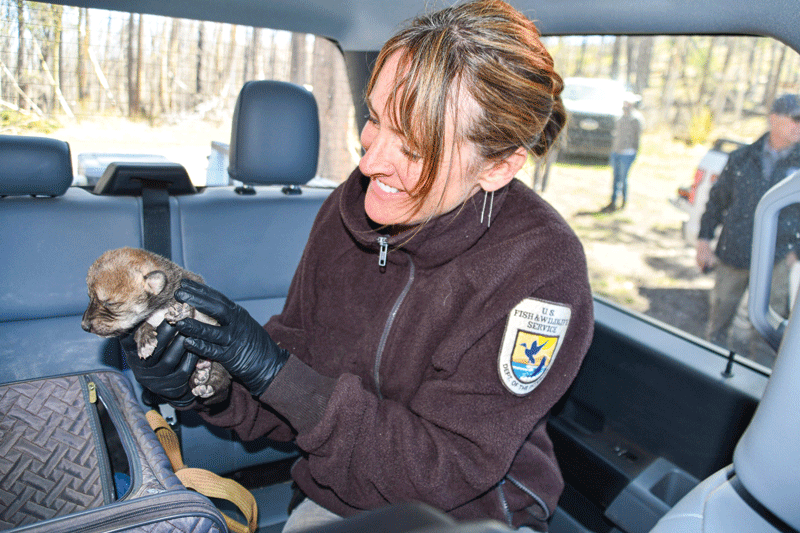
When Susan Dicks, DVM, goes to work in New Mexico, she spends her days giving vaccinations, examining neonatal puppies, and studying fecal samples. It seems like a regular day for a veterinarian, only her patients are not pets—they are Mexican wolves.
Dr. Dicks, who has a small animal background and was in clinical practice for 10 years, is employed by the U.S. Fish & Wildlife Service (USFWS) Mexican Wolf Recovery Program, which is working to bring the wolves back to a healthy population level in the Southwest, where they originated.
In addition to providing clinical care as needed to animals in the captive breeding program or wild wolves that have been brought in for care, Dicks also advises zoos with Mexican wolves. Her job has her dealing not only with individual animals, but also with population health; and with such a small population—approximately 257 according to the 2023 census—every individual counts.
“I find what I do in veterinary medicine unique,” Dick says. “Because of my background in small animal medicine, I had the dog as a model for a lot of wolf issues. Knowing dog anatomy, physiology, and pathology all help since the wolf is similar in anatomy and physiology.”
Natural history
In the Southwest, endangered Mexican gray wolves (Canis lupus baileyi) are beginning to make a comeback in their historic range of Arizona, New Mexico, and northern Mexico. The small wolves, sometimes called lobos, were extirpated in the wild by the 1970s1 because of concerns about conflicts with livestock, but enactment of the Endangered Species Act in 1973 gave them a second chance.
The lobos were listed as endangered in 1976, and the United States and Mexico worked together to create a captive breeding program—starting with just seven Mexican wolves found in Mexico—to halt the lobo’s lope toward extinction.
Toward that aim, the USFWS partners with the Arizona Game and Fish Department, the New Mexico Department of Game and Fish, the U. S. Department of Agriculture Forest Service, the USDA Animal and Plant Health Inspection Service Wildlife Services, the White Mountain Apache Tribe, the Bureau of Land Management, the National Park Service, and the Saving Animals From Extinction program.
The wolves’ population has grown for eight consecutive years, with a 2023 population census finding a minimum of 257 Mexican wolves distributed across Arizona and New Mexico. That is a six percent increase from the minimum of 242 wolves counted in 2022, according to the USFWS.
“We count the radio-collared animals and the uncollared that are with them during our annual survey. We also count uncollared animals with game cameras and sign searches, such as tracks and scat. We do genetics on scat so we can figure out individual Mexican wolves based on feces left in the landscape. It’s still not a ton both in captivity and in the wild, but it’s better than seven,” Dicks says.
In addition to the wild population, approximately 350 Mexican wolves are distributed throughout more than 60 facilities in the U.S. and Mexico. They help contribute to genetic diversity as Mexican wolves are brought back from the brink.
“The zoos propagated these animals and basically saved the species,” Dicks says. “The wolves were pulled out of the wild, they weren’t doing well down in the wild anymore, possibly were going to die without anybody really knowing. Then they were brought into managed care and carefully bred back from a founder population of seven. It just goes to show things can go full circle with a lot of effort.”
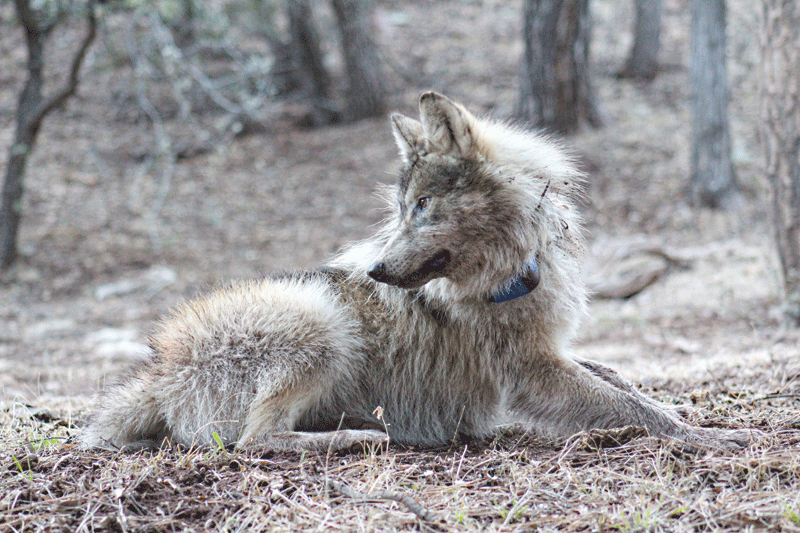
Distinct traits
Lobos are distinguished by their size and their coloration, Dicks says. Compared to other wolves, they are small, and their fur typically is a blend of black, tan, rust, gray, and buff, without the solid black or white variations seen in gray wolves. Both characteristics may have led to the suspicion they were mixed with dogs or coyotes, but Dicks says the size difference is normal. “In general, wolves in northern latitudes are larger and are smaller the farther south you go,” she says.
The lobos’ smaller size contributes to their suitability for the more arid environment they inhabit.2 Their range stretches from desert areas in southern New Mexico to the mountain woodlands of Valles Caldera in north-central New Mexico.
Mexican wolves were reintroduced to their original habitat in Arizona and New Mexico, known as the Mexican Wolf Experimental Population Area, in 1998 by the USFWS. From the beginning, their designation as a subspecies of the gray wolf was under fire, but a 2018 study2 confirmed they were genetically distinct from other wolf species and researchers found no evidence the Mexican wolf genome included DNA from domestic dogs, nor is there any evidence these wolves have interbred with coyotes.
“We’ve never documented hybridization with coyotes,” Dicks says. “Did it occur historically in all canids? Probably. Their genetics are all kind of mixed up going back millions of years, but we’ve not documented it. We are extremely careful with our genetics, both in the wild and especially in the captive community. Every wild wolf we capture, we verify the genetics, that this is 100 percent Mexican wolf. In the captive community in the zoos, we have a big stud book where we keep track of all the relatives, and very sophisticated genetic analyses are performed with regard to breeding recommendations.”
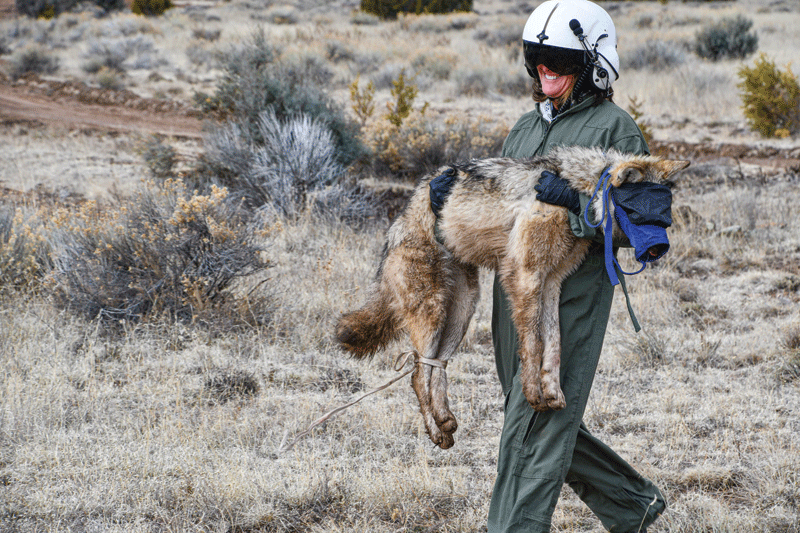
Pup relocation and genetic diversity
With an original foundation of only seven wolves, genetic diversity is essential for the healthy survival of lobos. In addition to consulting about breeding recommendations, Dicks has also become something of a neonate specialist. A favorite part of her job is simply observing the pups to make sure they are healthy enough to be moved out of zoos and into dens where they are readily adopted by wild wolves, a unique project proving to be very successful.
One thing Dicks and the USFWS Mexican Wolf Recovery Program team have learned is wolves are excellent parents and are accepting of newborns, their own or others.
“Because genetics and genetic issues are very important in our program, we take individual pups from zoo litters and fly them to Arizona or New Mexico when they are under 14 days of age,” Dicks says. “We match them to wild litters of similar age, put them in dens, and the pups go straight for the mom, and they’re adopted.”
Wolves breed and whelp only once a year, and during that time Dicks stays busy preparing for and monitoring litters. Radio collar data provides the information wild females are denning—and where.
“When they don’t move a lot for a couple of days, it’s usually a good sign there are pups. That’s something we follow up on closely.”
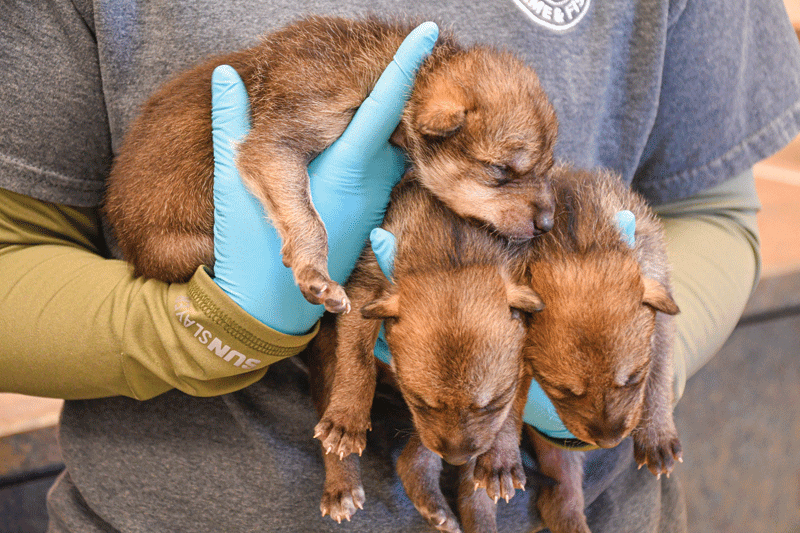
Technology counts
The sophisticated radio collars also aid the team in tracking and managing wolves. For instance, unlike many endangered species, Mexican wolves do not suffer from habitat loss. Instead, the challenge to their recovery is social tolerance.
In ranching country, it is essential to keep lobos from preying on a rancher’s livelihood: livestock. If a collar indicates a wolf is near cattle, someone goes out to haze them away. Some collars can provide biometric data about their wearers, but those are not in use yet for the wolves, Dicks says.
More basic, hands-on techniques are important, too. Experienced, knowledgeable volunteers scour known wolf territory for scat. Wolves often use easily accessible roads and trails, so it is not difficult to find.
In addition to using scat to identify individual wolves, Dicks examines it to get an idea of whether any parasites are circulating in the population. With the dry climate, parasites are rare, and the wild population tends to be healthy.
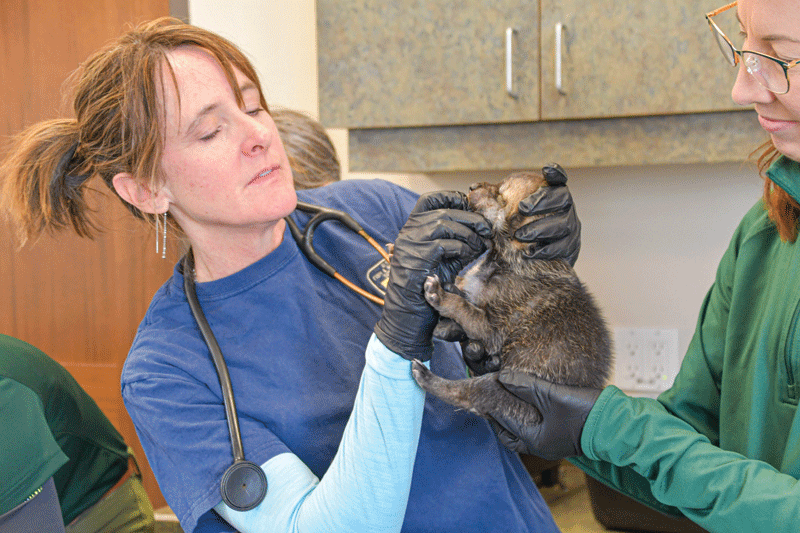
Veterinary contributions
Even for veterinarians who do not see wolves or other wildlife in their practices, knowledge of wildlife is important because of the potential for zoonotic diseases to transmit to other animals. Dicks notes Covid was an example of how veterinarians are uniquely placed to help protect wildlife, endangered species, and humans.
A large part of the job is educating people about the wolves. Whether speaking to veterinary professionals or children in classrooms, Dicks finds herself informing audiences about zoonotic diseases.
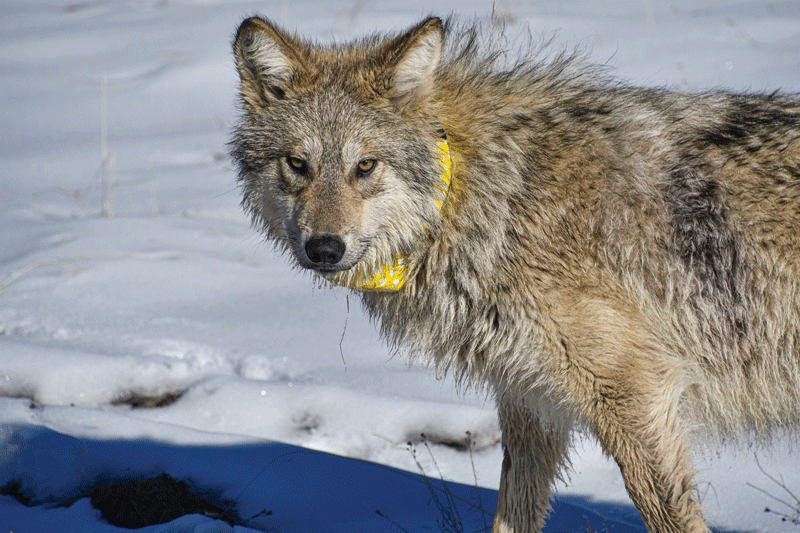
“We don’t see a lot of issues with our wolves, but globally, in areas where animals and humans interface and places where animals are losing habitat and being stressed, those are places where we can see zoonotic diseases pop up in wildlife. Learning about wildlife and their habitats helps both animals and humans.”
Even if they are not interested in being full-time wildlife veterinarians, Dicks encourages colleagues to seek out opportunities to volunteer with wildlife. “To study zoonotic diseases, you have to handle animals, and that is what veterinarians do,” she says.
For her, it has been a rewarding change in her career. “Mexican wolves are a neat story because here’s something humans got rid of out of the U. S. totally, and then we realized ‘Hey, this is an animal that was here that there’s room for possibly, and we should try and reintroduce.’”
Kim Campbell Thornton has been writing about dogs, cats, wildlife, and marine life since 1985, and is a recipient of multiple awards for her articles and books from the Cat Writers Association, Dog Writers Association of America, and American Society of Journalists and Authors.
